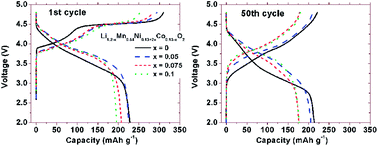Smart design of lithium-rich layered oxide cathode compositions with suppressed voltage decay
Abstract
The lithium-rich layered oxide cathodes offer a high capacity of ∼250 mA h g−1, but their commercialization is prevented by the problem of voltage decay during cycling, originating from a phase transformation to a 3 V spinel-like phase. With an aim of understanding the factors that govern the voltage decay, the effect of the length of the plateau region during first charge and the octahedral-site stabilization energy of the transition metal (TM) ions has been investigated by designing various compositions of lithium-rich layered oxides. Charge–discharge profile and dQ/dV plot variations during cycling confirm that the length of the plateau region during first charge is the primary governing factor in the voltage decay process. The voltage decay is enhanced by a lengthened plateau region that increases the kinetics of the phase transformation to the spinel-like phase due to the (i) formation of Litet–V(TM)Li–Litet dumbbells (Litet refers to the lithium ion in a tetrahedral site and V(TM)Li refers to the lithium-ion vacancy in the TM layer) because of the increased lithium-ion extraction from the TM layer and (ii) TM migration to the lithium layer assisted by a higher oxygen vacancy concentration. Based on this understanding, a new series of compositions Li1.2−xMn0.54Ni0.13+2xCo0.13−xO2 have been designed to minimize the plateau region during first charge without sacrificing the energy density. The optimized composition Li1.15Mn0.54Ni0.23Co0.08O2 exhibits superior electrochemical performance with a marked decrease in voltage decay during cycling compared to the well-known composition Li1.2Mn0.54Ni0.13Co0.13O2.


 Please wait while we load your content...
Please wait while we load your content...